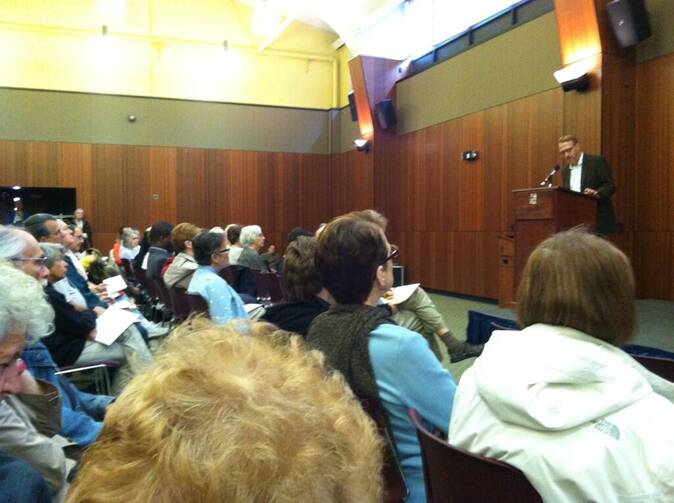Last week I wrote about what gives theologians hope. Today, I share about a theologian who gaves me hope this morning.
Christopher Pramuk, a theologian at Xavier University, delivered the opening plenary address on the second day of the International Thomas Merton Society (ITMS) conference. The gathering, which is being held at Sacred Heart University in Fairfield, CT, consists of more-than 250 Merton scholars and enthusiasts who come together to share research and celebrate the life and work of one of the Twentieth Century’s most famous spiritual figures.
In addition to being a well-respected systematic theologian and Merton scholar, Pramuk is a fellow member of the ITMS Board of Directors and was recently re-elected by the Society for a second two-year term. The author of several books, including the award-winning Sophia: The Hidden Christ of Thomas Merton (2009) and Hope Sings, So Beautiful: Graced Encounters Across the Color Line (2013), Pramuk brought together two of his primary theological and personal interests – as represented by the respective subjects of these two texts – in his deeply moving plenary address.
Early in his address, which was titled “‘She Cannot Be a Prisoner’: The Lure of Wisdom as Bearer of Hope,” Pramuk said: “Hope is the capacity to imagine again.” In what followed, a deeply poetic, theologically rich, and vulnerably personal reflection on Merton, Sophia, sin and suffering, and hope unfolded.
Centered on Merton’s famous prose poem, “Hagia Sophia,” as its starting point and connecting thread, Pramuk’s address drew the packed room of people into his welcoming and humble presentation, which concluded with an audience member rising to request two minutes of silence to let the profundity of what was shared sink in.
About the poem and its significance for us today, Pramuk said: “Merton is not just painting pretty pictures in ‘Hagia Sophia’…he seeks to articulate a Divine presence worthy of our hope,” adding that it was also a mode of presence faithful to the tradition.
In addition to Merton, who was a constant companion along this theological pilgrimage, Pramuk drew from the wisdom and insight of such diverse theologians as Rowan Williams and Melissa Raphael. He referenced Williams, the former Archbishop of Canterbury, who said of Merton that what made the Trappist monk so significant wasn’t his “originality,” but the exact opposite. Not that he sought to be fashionable, creative, or innovative, but that in reading Merton the reader was drawn to look at what Merton was ultimately looking at: God.
The second section of Pramuk’s paper was dedicated to following the former head of the Anglican Communion’s insight – engaging the question of finding wisdom, hope, and God in our day alongside our Jewish brothers and sisters, a faith community important to Merton.
Here he cited Etty Hillisum, suggesting that the theological question after the Shoah or Holocaust was not simply, “Where is God?” but “Who is God in the unfolding of the Shoah. In addition to Hillisum, Pramuk drew heavily from the powerful theological wisdom of Raphael, the author of The Female Face of God in Auschwitz: A Jewish Feminist Theology of the Holocaust (2003). In challenging typical theodicy, Raphael argues that in post-Shoah theology, the patriarchal God is in fact accused for not being patriarchal enough. The question about omnipotence can lead us to miss the point, to miss God.
Pramuk concluded his talk with a personal story about the birth and adoption of one of his sons, who was born in Haiti. For more, one can see his latest book Hope Sings, So Beautiful.
Pramuk’s presentation was absolutely captivating and represented the best in both honest personal reflection and theological scholarship. He certainly gave me hope, something that was echoed throughout the day by others in attendance.
The rest of the day included several concurrent paper sessions dealing with topics including Merton’s poetry, Interreligious dialogue, Merton and peacemaking, Vatican II, and pedagogical insights and teaching Merton in the classroom today. The historical theologian Elizabeth Dreyer, of Fairfield University, delivered the afternoon plenary address. Tonight’s events include a musical celebration with Deanna Witkowski, a jazz musician from New York. Highlights tomorrow include a morning panel on “Thomas Merton and Henri Nouwen” and a public keynote lecture by Ron Rolheiser, OMI.








